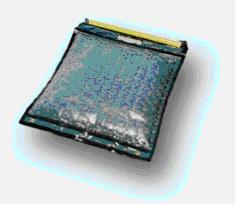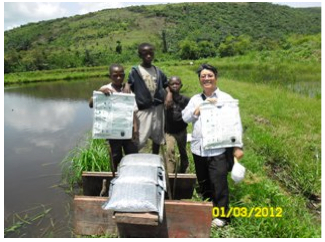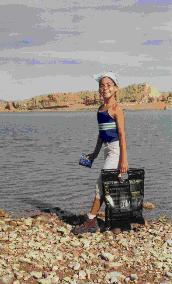AquaPak Solar Water heater and Pasteurizer


The AquaPak uses cloth roughing filtration and solar disinfection to treat contaminated water. It is made from low cost polyethylene plastic (also used in food preparation boiling bags) with UV inhibitors added, and air-filled bubble pack sheeting (originally developed for the packing industry), the AquaPak can heat water to temperatures up to 65 degrees Celsius, a temperature that will kill waterborne pathogens using only sunlight. The AquaPak employs a reusable sealed glass tube indicator, called WAPI, filled with coloured wax at one end that melts when heated to the required temperature, indicating the completion of the pasteurization process. Depending on the availability of sunlight throughout the day, an AquaPak can produce up to 10 litres of water per day.
Education or training can improve people’s willingness to implement the product.
AquaPak is only effective for microbiologically contaminated water, so it should be used in combination with other treatment methods when input water is contaminated with specific chemical substances.
The AquaPak was first developed 10 years ago. Since then, it has been tested and used in 57 countries.
Suitable conditions
| Advantages | Disadvantages |
|---|---|
| - Effectiveness not affected by turbidity Inexpensive to manufacture (US$ 2,00) - Simple operation, locally manufacture - Utilization of renewable energy source: solar energy - Elevate life quality such as job creation and local economy development in area where local manufacturing scheme is implemented |
- It only works on sunny days - Time involved in treating the water |
The AquaPak is specifically developed for individual use. It requires lots of sunlight. Users should carry chlorine tablets supplies in case of insufficient sunlight.
|
|
Construction, operations and maintenance
Water is filled into the AquaPak and then places it in direct sunlight for at least three hours. To ensure complete pasteurization it is important that the orange wax in the WAPI completely melts and becomes clear indicating 65°C has been reached
For maximum effectiveness when using AquaPak outside the Tropics of Capricorn and Cancer it is best to fill the AquaPak only to minimum water level line until you ensure you have enough solar radiation to process additional water. The detachable reflector can be used to help increase solar radiation
The plastic bag and glass WAPI need to be handled appropriately, since they can be broken or torn. The fittings such as WAPI, WAPI cap, filter cap, foam insulation, handle, etc, can be used for the next bag. The sealing bonds the edges of the plastic tightly enough for the AquaPak to pass a 3 metres drop test when filled with 3 litres of 70°C water
Complete instructions are available at the back of the bag.
Maintenance
Practically no maintenance required.
Manufacturing
The business model of the AquaPak is to help developing world entrepreneurs to establish AquaPak “copy exactly” manufacturing facilities where demands are present.
The AquaPak is laboratory tested. Tests were conducted by BioVir Laboratories, San Francisco, USA, on virus contaminated water and by Environmental Engineering
Estimated Lifespan
The AquaPak should last at least one year before the solar UV deteriorates the Polyethylene plastic to a point where it may not work efficiently.
Suppliers
Solar Solutions laboratory.
Costs
Depending on the manufacturing cost. Although a target is set at US$ 2,00 per unit.
| Capital cost | Operating cost | Replacement cost | Estimated 5 year cost | Cost / metre cubed treated |
|---|---|---|---|---|
| US$ 2 = €1,4 / unit | €27,40-337,80 | US$ 1 = € 0,7 (PE bag), US$ 1 = € 0,7(Fittings) | € 3,13 |
Field experiences
The Innovation Institute at Henry Ford (II-HF) proudly donated Aquapaks to the the World Health Student Organization (WHSO) of Wayne State University School of Medicine (WSU-SOM). When WHSO went on their medical mission trip to Ecuador in March of 2012, they documented the great impact the Innovation Institute's gift made on the people in the village of Agua Blanca.
- Video: AquaPak in Ecuador.
Reference manuals, videos, and links
- Solar Solutions
- Video demonstration: AquaPak - Solar Water Pasteurizer.
Acknowledgements
This article is based on a factsheet from Aqua For All…..

